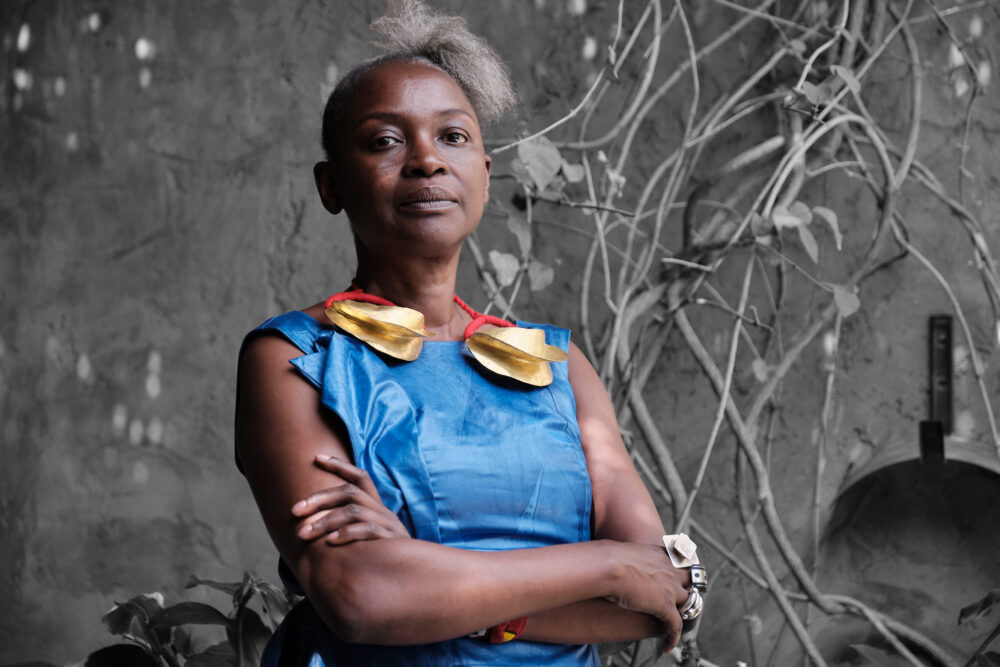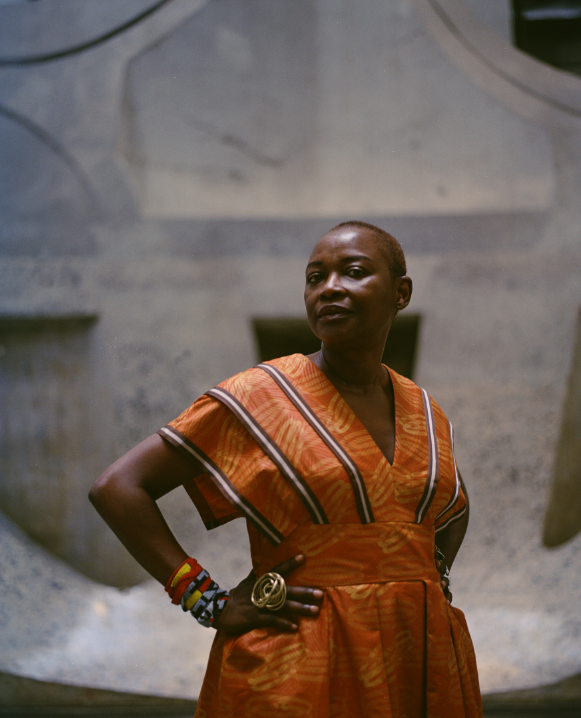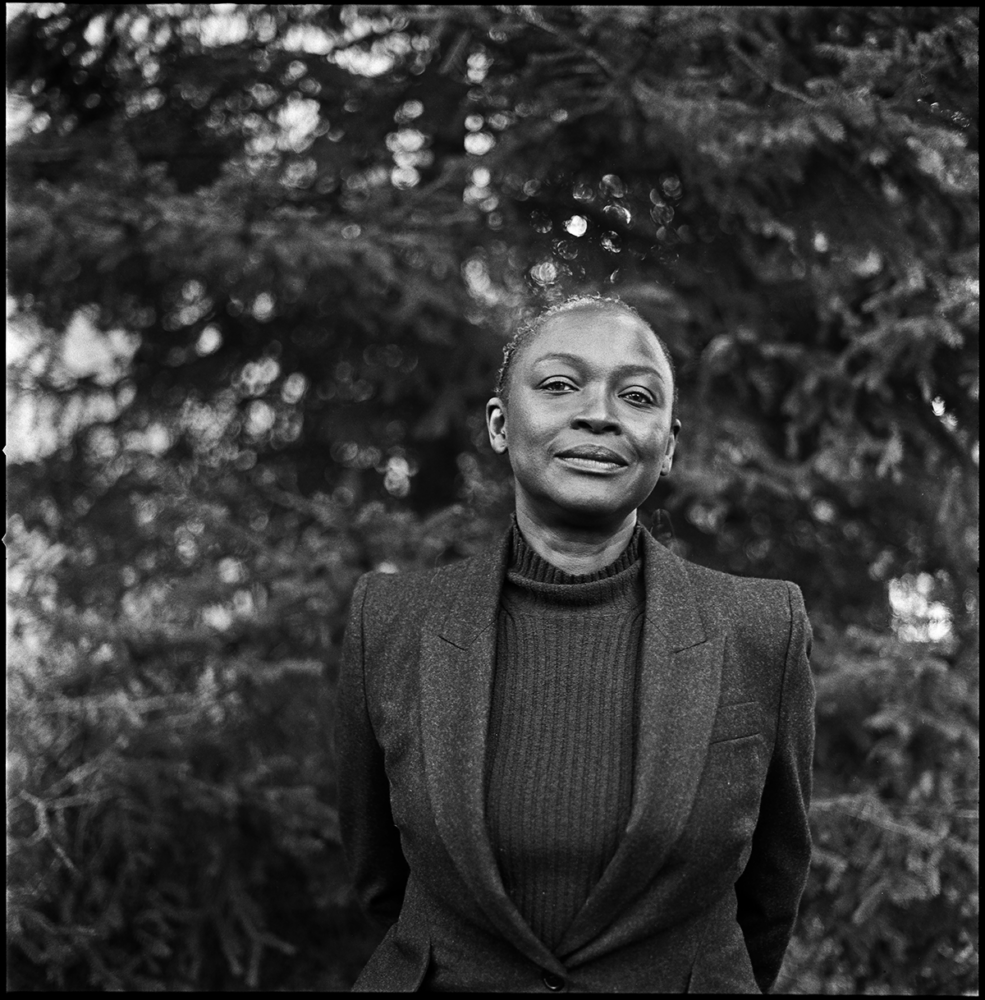Cameroonian-Swiss curator Koyo Kouoh, who died of cancer on 10 May, was executive director and chief curator of the Zeitz Museum of Contemporary Art Africa in Cape Town. Photo by Mirjam Kluka
In the days since Koyo Kouoh died on Saturday 10 May at the age of 57, tributes have flowed in locally and from all over the world, including a heartfelt requiem by Bongani Madondo in the pages of the Mail & Guardian. Zeitz Museum of Contemporary Art Africa (MOCAA) — where the Cameroonian-Swiss culture worker had served as executive director and chief curator since 2019 — has a dedicated tributes page in her honour.
“We have collectively lost a giant! It’s like the soil has been pulled off under our feet,” Bonaventure Soh Bejeng Ndikung told me this week.
Ndikung, himself a towering figure in contemporary art and director of Berlin’s Haus der Kulturen der Welt, shared a personal and expansive portrait of Kouoh — not merely as a colleague and collaborator but as an enduring presence and influence in his life.
Long before her leadership at Zeitz MOCAA, Kouoh was already shaping the contours of the contemporary African art scene. As founder of Raw Material Company in Dakar, Senegal, her vision inspired Ndikung in the founding of his own institutions.
“She had done quite some work with African artists … and being herself somebody of Cameroonian origin, like myself, I looked up to her,” he said.
Their bond spanned over 15 years, anchored in mutual admiration and shared projects.
Ndikung recounted their work on the series Condition Report, an ambitious initiative that brought together artists and curators of African origin from around the world to assess and articulate the state and future of contemporary African art. The project culminated in books, ideas and gatherings that pushed the field forward in critical and imaginative ways.
Kouoh’s vision was global and deeply rooted. As Ndikung recalled, her curatorial scope refused the confinement of continental boundaries. Whether exploring Atlantic or Indian Oceanic diasporas — as in the groundbreaking Indigo Waves and Other Stories at Zeitz MOCAA — she centred the African world in all its multiplicities. That exhibition, which Ndikung co-curated, invited viewers to reimagine geography and cultural flow.
It was preceded by a poetic gathering of artists and thinkers, an invocation of spirit and solidarity where Kouoh read a poem she had written for the occasion.
Their relationship was also one of deep personal trust. Ndikung remembered how Kouoh was the one who urged him to apply for his position at the Haus der Kulturen der Welt. “She played a very important role beyond collaboration … when I would be in an impasse, she was one of the few people I would call to ask for advice.”
Her pan-Africanism, he said, was not just ideological — it was practised, lived and grounded in networks that spanned Brazil, the US, Europe and the continent itself. As he put it, “If the label of pan-African ever fits anybody, it is a hat that fits her best.”
 Photo by Emeka Okereke
Photo by Emeka Okereke
One of Kouoh’s most significant and complex artistic relationships was with the South African artist Tracey Rose. The two were introduced by the writer and curator Simon Njami at a dinner party in Dakar — a moment that seeded a deep, evolving collaboration.
Over the years, Rose would feature prominently in Kouoh’s curatorial orbit, including in Still (the) Barbarians, Kouoh’s 2016 exhibition for EVA International in Ireland, and Body Talk, a landmark traveling show that tackled feminism, sexuality and the black female body. Kouoh also oversaw the curation of Shooting Down Babylon, Rose’s 30-year tri-continental retrospective.
Their personal and professional bond deepened — and eventually fractured. The relationship could not survive the pressures and divergences that can mark long, passionate collaborations. When contacted, Rose was at first reluctant to speak but ultimately chose to reflect on Kouoh’s legacy in her own terms.
“Koyo’s ambitious impact on contemporary African art was the result of an authentic commitment to a romantic idealism of what Africa is within global art and culture,” Rose said. “Her gift of creating an environment for our Contemporary Cave is a vision she was forming, to be [fully] realised in this now incomplete sentence of her life.”
Artist and gallery founder Banele Khoza met Kouoh more recently, in 2020, when she attended the opening of BKhz’s Cape Town pop-up. Though she declined to speak at the event due to its commercial nature, her presence alone was a profound validation for Khoza. “Outside of her, there was no one else I would have considered to open the space,” he recalled.
Their direct collaborations were limited but Kouoh included Khoza’s work in Selections from the Collection, a years-long exhibition at Zeitz MOCAA that will remain on view until 2027 — an enduring testament to her support for emerging voices. Khoza sees the inclusion as a final gift.
But it was her poise, charisma and insight that left the deepest impression. He recalled watching her command a room at a party with an elegance that taught him, in subtle ways, how to navigate visibility and preserve one’s energy.
“She was, and is, the ultimate matriarch in the African art scene,” Khoza said. “Her life has shown what is possible — many African curators now know that it’s possible for them to be considered for the ultimate curatorial job.”
Indeed, Kouoh had been selected to curate the 2026 Venice Biennale — a historic appointment that sent waves of excitement and anticipation across the art world. She would have been the first African woman to hold the role. For many, this next chapter in her career promised to mark a major turning point for African representation on one of the world’s most visible art stages.
Khoza, reflecting on what might have been, added: “I hope they honour her vision, though. It’ll be a reset and a first where everyone will be visiting the event to honour her life’s efforts and also respect the artists that are chosen.”
 Photo by Andile Buka
Photo by Andile Buka
Tributes to Kouoh’s impact stretch across decades. Federica Angelucci of Stevenson Gallery remembers their first email exchange 17 years ago regarding a possible exhibition at RAW. Their first in-person conversation at the Joburg Art Fair began with observations on style and segued into art. This seamless blend of personal and professional was characteristic of Kouoh’s way of being.
In Bamako in 2011, Angelucci spoke after Kouoh on a panel and remembered feeling inadequate following her passionate call to rethink African institutions. That urgency never waned. Whether at the Hamburg Triennale or in preparations for Mame-Diarra Niang’s 2023 survey at Zeitz MOCAA, Kouoh brought not only “generosity, inner gravitas and imaginative power” but a vision rooted in care. Even in moments of disagreement, the respect was unwavering.
“People are more important than art,” Angelucci said. “It is her teaching I want to keep going by.”
Liza Essers, owner and director of Goodman Gallery, recalled her relationship with Kouoh dating back nearly two decades. They met alongside curators Okwui Enwezor, Simon Njami and Bisi Silva, all of whom, like Kouoh, shaped the architecture of African art before departing far too soon.
“She managed to build an institution that is firmly rooted in what African artists and curators are thinking and doing,” Essers said.
She admired Kouoh’s insistence on framing African practices on their own terms — resisting the pressure to fit into Western paradigms. That ethos aligned naturally with Raw’s inclusion in the SOUTH SOUTH platform during the pandemic and in supporting Kouoh’s appointment at Zeitz MOCAA. Under her leadership, the museum blossomed into a true global force, drawing artists, thinkers and collectors such as Julie Mehretu, Jorge M Pérez and Yinka Shonibare to its orbit.
“Koyo will always be remembered as an institution-builder, an incredible thinker and a visionary who brought the world to Africa,” Essers said.
 Photo by Mehdi Benkler
Photo by Mehdi Benkler
Ntone Edjabe, founder of Chimurenga, first began corresponding with Kouoh in the late Nineties, as both were building new institutions — Chimurenga in Cape Town and, eventually, RAW in Dakar. Their friendship was born of that early solidarity and nurtured over years of collaboration.
When Edjabe visited Dakar in 2004, Kouoh became his guide to the city and its cultural topography. “She introduced the city to me,” he recalled. “I fell in love with it by seeing it through her eyes.”
Their shared interest in alternative education led to one of Kouoh’s most important initiatives: RAW Academy. Launched in the mid-2010s, the programme offered an experimental approach to artistic training and discourse on the continent.
Edjabe directed the second session of the academy, marking another moment in their long-standing creative dialogue. “It was a continuous exchange,” Edjabe said. “Even when we were not working on specific projects, we were imagining together.”
Kouoh, he said, belonged to a rare cohort — figures like Enwezor and Silva — who expanded the intellectual and institutional horizons of African art. Their recent deaths, all in their fifties, has left a generation reeling. “Koyo was part of this group,” he said. “It’s only after the departure that we begin to estimate the impact.”
Her death from cancer is not only a personal loss for those who loved her, but a monumental one for the world of art. Kouoh’s legacy is one of expansion — of geography, of thought, of possibility. She opened doors and created rooms that hadn’t existed before. And while her journey has been cut short, the paths she carved remain wide and open for others to walk on.
As Bonaventure put it, “It’s a loss we cannot quantify.”